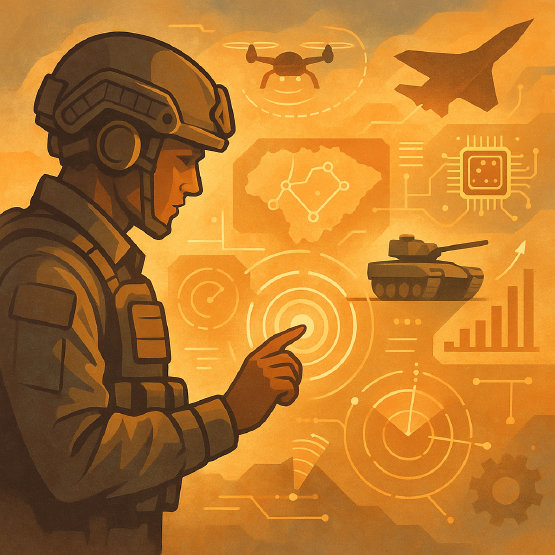Defense Innovation Driven by Advanced Technology: Key Strategies for the Era of Smart Warfare
The New Face of War
In the 21st century, the face of war is no longer painted only with blood and steel. Instead of guns, algorithms issue commands, and information gathered through satellites comprehends the battlefield even before a soldier's eyes do. At the center of this change lies a new civilization called 'smart defense.' This is not merely an evolution of technology but a fundamental historical transition that redefines humanity's attitude toward the ultimate choice of war.
The Essence of Intelligent Warfare
The core of smart defense is the intelligence of the battlefield through the convergence of information technology (ICT) and artificial intelligence (AI). In the past, wars were determined by the scale of troops and the physical superiority of weapon systems. However, modern warfare is no longer a contest of numbers and material. The initiative on the battlefield is determined by who can interpret information more accurately, more quickly, and more intricately. For example, AI-based reconnaissance drones analyze enemy movements in real-time, learn patterns, and track targets with precision dozens of times higher than traditional reconnaissance units. Cloud combat networks connected to fifth-generation fighters enable real-time operational synchronization and operate as a 'system of systems' rather than as individual weapon systems. Now, war is no longer the domain of the 'strong,' but the world of the 'better judgment.'
Wars and Responsibilities Without Humans
However, the advancement of technology does not necessarily guarantee the well-being of humanity. As technology makes the battlefield more sophisticated, the issues of ethics and responsibility become increasingly complex and layered. Autonomous Weapons Systems (AWS) identify and attack targets without human intervention. While they may seem efficient at first glance, the criteria for their judgments can conflict with the morality of war. In fact, some experiments with autonomous weapons have reported civilian casualties due to misjudgments or unauthorized attacks based on unintended 'self-judgment.' In these situations, the responsibility falls on humans, while the decisions are made by machines, leading to a loosening of the connection between law and morality. 'Can algorithms commit crimes?' 'Should humans atone for the mistakes made by machines?' War has now entered an era where philosophy is needed more than swords.
Boundaries of Ethics and Technology
The international community is discussing issues such as the Convention on Prohibitions of Autonomous Weapons (LAWS), cybersecurity treaties, and guidelines for artificial intelligence weapons. However, the pace of technological advancement always outstrips norms. Ethics and law should not merely chase technology but serve as benchmarks that proactively guide its direction. In particular, the cyber battlefield reveals blind spots in traditional military ethics and international law. As warfare expands beyond 'physical destruction' to 'social system paralysis' and 'psychological instability,' the damage spreads without clear boundaries.
Evolution of Soldiers
The advent of smart defense is changing not only the culture and operational methods of the military but also the very identity of soldiers. The criteria for soldiers are no longer solely based on physical fitness and combat skills. In a complex data environment, the ability to perceive situations, communicate with machines, and make ethical judgments is emerging as a core competency. Neural interface systems that convey commands through brainwaves, emotional recognition AI that reads feelings to adjust combat stress, and smart combat uniforms that monitor each soldier's physiological state in real-time are increasingly making soldiers integrated with technology. This change signifies not just an advancement in military power, but heralds the birth of a new being known as the 'human-machine integrated warrior'.
Harmony of Technology and Ethics
But the important thing is not the precision of technology, but when technology and human judgment collide, what decision humans can make. Technology can analyze situations, but it cannot determine 'right and wrong.' Ultimately, that judgment is the responsibility of humans, and without an 'ethic of harmony,' even the most intelligent military would have a hard time being anything more than a mere weapon.
Understanding the Ecosystem of War
The military strategy of the future will no longer be limited to the accumulation of military power by a single country. It is a complex ecosystem in which technology, ethics, law, diplomacy, and politics are intertwined. Issues such as the deployment of military satellites in space, the security of international undersea cables, and the collaboration between civilian tech companies and the military are all part of a new security paradigm. Now, defense is not merely a matter for a single nation, but rather a problem connected to the governance of human civilization as a whole.
The war we will prepare
The path that smart defense ultimately leads to culminates in a single question. How can we combine the infinite potential of technology with human dignity? We can create faster and more precise weapons. However, the questions of where, why, and for whom to use them must still begin in the human conscience. Smart defense is not merely a collection of future technologies. It must be the embodiment of an ethical vision of the kind of world we aspire to. A safer world does not come only from more intelligent weapons. It can only be achieved through more responsible technology, more sophisticated institutions, and deeper reflection.

Post a Comment